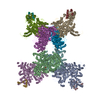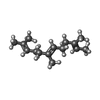+ Open data
Open data
- Basic information
Basic information
| Entry | Database: PDB / ID: 8jfl | ||||||
|---|---|---|---|---|---|---|---|
| Title | PhK holoenzyme in active state, muscle isoform | ||||||
 Components Components |
| ||||||
 Keywords Keywords |  CYTOSOLIC PROTEIN / glycogen phosphorylase b kinase / muscle isoform / Ca2+ active state CYTOSOLIC PROTEIN / glycogen phosphorylase b kinase / muscle isoform / Ca2+ active state | ||||||
| Function / homology |  Function and homology information Function and homology information phosphorylase kinase / phosphorylase kinase /  phosphorylase kinase activity / phosphorylase kinase activity /  phosphorylase kinase complex / phosphorylase kinase complex /  tau-protein kinase / glycogen biosynthetic process / Glycogen breakdown (glycogenolysis) / tau-protein kinase / glycogen biosynthetic process / Glycogen breakdown (glycogenolysis) /  tau-protein kinase activity / glycogen metabolic process / generation of precursor metabolites and energy / tau-protein kinase activity / glycogen metabolic process / generation of precursor metabolites and energy /  calmodulin binding ... calmodulin binding ... phosphorylase kinase / phosphorylase kinase /  phosphorylase kinase activity / phosphorylase kinase activity /  phosphorylase kinase complex / phosphorylase kinase complex /  tau-protein kinase / glycogen biosynthetic process / Glycogen breakdown (glycogenolysis) / tau-protein kinase / glycogen biosynthetic process / Glycogen breakdown (glycogenolysis) /  tau-protein kinase activity / glycogen metabolic process / generation of precursor metabolites and energy / tau-protein kinase activity / glycogen metabolic process / generation of precursor metabolites and energy /  calmodulin binding / calmodulin binding /  non-specific serine/threonine protein kinase / carbohydrate metabolic process / non-specific serine/threonine protein kinase / carbohydrate metabolic process /  phosphorylation / protein serine kinase activity / phosphorylation / protein serine kinase activity /  enzyme binding / enzyme binding /  ATP binding / ATP binding /  plasma membrane / plasma membrane /  cytosol cytosolSimilarity search - Function | ||||||
| Biological species |   Homo sapiens (human) Homo sapiens (human) | ||||||
| Method |  ELECTRON MICROSCOPY / ELECTRON MICROSCOPY /  single particle reconstruction / single particle reconstruction /  cryo EM / Resolution: 2.9 Å cryo EM / Resolution: 2.9 Å | ||||||
 Authors Authors | Yang, X.K. / Xiao, J.Y. | ||||||
| Funding support |  China, 1items China, 1items
| ||||||
 Citation Citation |  Journal: Nat Commun / Year: 2024 Journal: Nat Commun / Year: 2024Title: Architecture and activation of human muscle phosphorylase kinase. Authors: Xiaoke Yang / Mingqi Zhu / Xue Lu / Yuxin Wang / Junyu Xiao /  Abstract: The study of phosphorylase kinase (PhK)-regulated glycogen metabolism has contributed to the fundamental understanding of protein phosphorylation; however, the molecular mechanism of PhK remains ...The study of phosphorylase kinase (PhK)-regulated glycogen metabolism has contributed to the fundamental understanding of protein phosphorylation; however, the molecular mechanism of PhK remains poorly understood. Here we present the high-resolution cryo-electron microscopy structures of human muscle PhK. The 1.3-megadalton PhK αβγδ hexadecamer consists of a tetramer of tetramer, wherein four αβγδ modules are connected by the central β scaffold. The α- and β-subunits possess glucoamylase-like domains, but exhibit no detectable enzyme activities. The α-subunit serves as a bridge between the β-subunit and the γδ subcomplex, and facilitates the γ-subunit to adopt an autoinhibited state. Ca-free calmodulin (δ-subunit) binds to the γ-subunit in a compact conformation. Upon binding of Ca, a conformational change occurs, allowing for the de-inhibition of the γ-subunit through a spring-loaded mechanism. We also reveal an ADP-binding pocket in the β-subunit, which plays a role in allosterically enhancing PhK activity. These results provide molecular insights of this important kinase complex. | ||||||
| History |
|
- Structure visualization
Structure visualization
| Structure viewer | Molecule:  Molmil Molmil Jmol/JSmol Jmol/JSmol |
|---|
- Downloads & links
Downloads & links
- Download
Download
| PDBx/mmCIF format |  8jfl.cif.gz 8jfl.cif.gz | 1.5 MB | Display |  PDBx/mmCIF format PDBx/mmCIF format |
|---|---|---|---|---|
| PDB format |  pdb8jfl.ent.gz pdb8jfl.ent.gz | 1.2 MB | Display |  PDB format PDB format |
| PDBx/mmJSON format |  8jfl.json.gz 8jfl.json.gz | Tree view |  PDBx/mmJSON format PDBx/mmJSON format | |
| Others |  Other downloads Other downloads |
-Validation report
| Arichive directory |  https://data.pdbj.org/pub/pdb/validation_reports/jf/8jfl https://data.pdbj.org/pub/pdb/validation_reports/jf/8jfl ftp://data.pdbj.org/pub/pdb/validation_reports/jf/8jfl ftp://data.pdbj.org/pub/pdb/validation_reports/jf/8jfl | HTTPS FTP |
|---|
-Related structure data
| Related structure data |  36213MC  8jfkC  8xy7C  8xyaC  8xybC M: map data used to model this data C: citing same article ( |
|---|---|
| Similar structure data | Similarity search - Function & homology  F&H Search F&H Search |
- Links
Links
- Assembly
Assembly
| Deposited unit | 
|
|---|---|
| 1 |
|
- Components
Components
| #1: Protein | Mass: 137469.422 Da / Num. of mol.: 4 Source method: isolated from a genetically manipulated source Source: (gene. exp.)   Homo sapiens (human) / Gene: PHKA1, PHKA / Production host: Homo sapiens (human) / Gene: PHKA1, PHKA / Production host:   Homo sapiens (human) / References: UniProt: P46020 Homo sapiens (human) / References: UniProt: P46020#2: Protein | Mass: 45084.672 Da / Num. of mol.: 4 Source method: isolated from a genetically manipulated source Source: (gene. exp.)   Homo sapiens (human) / Gene: PHKG1, PHKG / Production host: Homo sapiens (human) / Gene: PHKG1, PHKG / Production host:   Homo sapiens (human) Homo sapiens (human)References: UniProt: Q16816,  phosphorylase kinase, phosphorylase kinase,  non-specific serine/threonine protein kinase, non-specific serine/threonine protein kinase,  tau-protein kinase tau-protein kinase#3: Protein | Mass: 125032.961 Da / Num. of mol.: 4 Source method: isolated from a genetically manipulated source Source: (gene. exp.)   Homo sapiens (human) / Gene: PHKB / Production host: Homo sapiens (human) / Gene: PHKB / Production host:   Homo sapiens (human) / References: UniProt: Q93100 Homo sapiens (human) / References: UniProt: Q93100#4: Chemical | ChemComp-FAR /  Farnesol Farnesol#5: Chemical | ChemComp-ADP /  Adenosine diphosphate Adenosine diphosphateHas ligand of interest | Y | |
|---|
-Experimental details
-Experiment
| Experiment | Method:  ELECTRON MICROSCOPY ELECTRON MICROSCOPY |
|---|---|
| EM experiment | Aggregation state: PARTICLE / 3D reconstruction method:  single particle reconstruction single particle reconstruction |
- Sample preparation
Sample preparation
| Component | Name: phosphorylase b kinase, muscle isoform, Ca2+ active state Type: COMPLEX / Entity ID: #1-#3 / Source: RECOMBINANT |
|---|---|
| Source (natural) | Organism:   Homo sapiens (human) Homo sapiens (human) |
| Source (recombinant) | Organism:   Homo sapiens (human) Homo sapiens (human) |
| Buffer solution | pH: 8.2 |
| Specimen | Embedding applied: NO / Shadowing applied: NO / Staining applied : NO / Vitrification applied : NO / Vitrification applied : YES : YES |
Vitrification | Cryogen name: ETHANE |
- Electron microscopy imaging
Electron microscopy imaging
| Experimental equipment |  Model: Titan Krios / Image courtesy: FEI Company |
|---|---|
| Microscopy | Model: FEI TITAN KRIOS |
| Electron gun | Electron source : :  FIELD EMISSION GUN / Accelerating voltage: 300 kV / Illumination mode: SPOT SCAN FIELD EMISSION GUN / Accelerating voltage: 300 kV / Illumination mode: SPOT SCAN |
| Electron lens | Mode: OTHER / Nominal defocus max: 1500 nm / Nominal defocus min: 1100 nm |
| Image recording | Electron dose: 1.5 e/Å2 / Film or detector model: GATAN K3 (6k x 4k) |
- Processing
Processing
CTF correction | Type: NONE |
|---|---|
3D reconstruction | Resolution: 2.9 Å / Resolution method: FSC 0.143 CUT-OFF / Num. of particles: 432047 / Symmetry type: POINT |
 Movie
Movie Controller
Controller







 PDBj
PDBj







